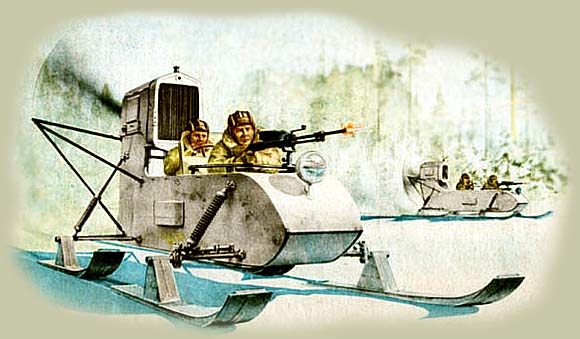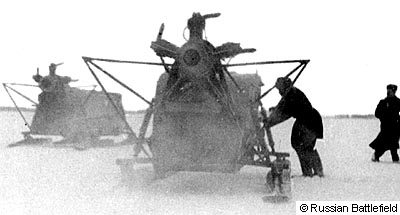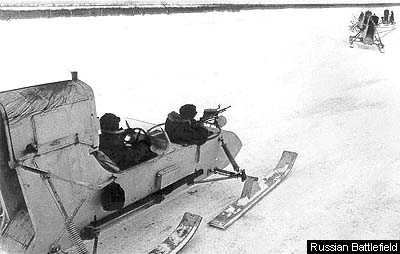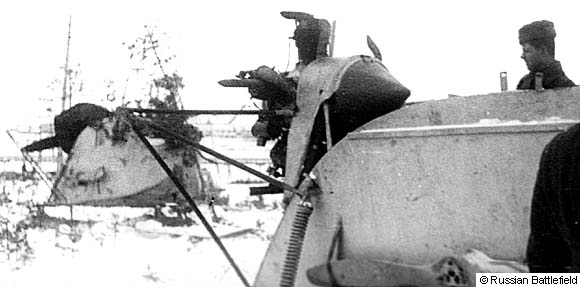|
|

 Soviet ski troop. Some NKL-16 aerosleds at the background. |
The story of the appearance of aerosleds in USSR country begins in Tsarist Russia. Indeed, the first aerosleds were designed and built even at the beginning of the Twentieth Century, soon after the development of relatively compact internal combustion engines. These machines were hardly intended for military purposes, but rather as light, all-terrain transport and recreational means. The enormous expanse of Russia, coupled with a weakly developed road network and the harsh climatic conditions of the Far North long ago challenged designers with the task of creating a reliable and rapid means of winter transportation. Therefore, in 1912, shortly before World War I, mass production of transport aerosleds was begun in the Russo-Balt (Russian-Baltic Plant). Despite this fact, aerosleds were seldom used in the war (the believed first use occurred in 1915). In any case, this author was unable to find any significant number of facts regarding the military employment of aerosleds.
The Civil War broke out soon after the end of World War I. The young Bolshevik Regime lacked in everything: provisions, fuel, and weaponry. Transport was almost ineffective in many regions. The winter of 1918-1919 was characterized by especially heavy snowfall, essentially severing communications with many outlying regions of the country. Analyzing the combat experience of World War I and having heard a report by A. S. Kuzin, "Concerning Machines that Can Move Across Snow," the Council of Labor and Defense issued instructions for the creation of a Commission for the Organization of the Design of the Aerosled (KOMPAS). The membership of the commission included such leading designers as N. E. Zhukovskiy, who became its scientific director; N. R. Briling, who was selected as director of KOMPAS (it was Briling himself who had laid the foundation for aerosled design in Tsarist Russia); and designers A. A. Arkhangelskiy, A. N. Tupolev, E. A. Chudakov, A. A. Mikulin, B. S. Stechkin, and A. S. Kuzin.
The commission was tasked with scientific-technical research, development of the construction process, and design and testing of an aerosled for employment in the military role. Work was begun for the creation of special snowmobiles. The first lot of forty aerosleds was completed by early September 1919. A short time later, in early 1920, work was begun on the preliminary design for the BK series aerosled [BK = Briling and Kuzin, some sources uses BEKA instead]. The sleds of this series took part in the suppression of the tragically famous Kronshtadt Rebellion occurred in March 1921, and one of the crew members was even awarded the Order of the Red Banner.
 NKL-16 aerosled. |
In addition to these new aerosleds, the Bolsheviks made use of the remaining old but serviceable aerosleds that had been handed down from the Tsarist Russian Army. These machines were used for maintaining operational communications, deliveries of ammunition and foodstuffs to the front line along roadless areas, and evacuation of wounded from combat positions.
Several types of aerosleds were created under the auspices of KOMPAS in the period from 1921 to 1923. The most interesting of these are the ANT-I and ANT-II, designed by A. N. Tupolev, and as well the ARBES and ARBES-II, designed by A. A. Arkhangelskiy and B. S. Stechkin.
By early 1923, two basic directions had been determined in aerosled designs. NAMI [Central Order of the Red Banner scientific-research automobile and auto-motor institute] showed a preference for wood construction and TsAGI [Central Aero-Hydrodynamic Institute] began to develop all-metal vehicles from kolchug-aluminum-a new and very promising (for that time) light casting.
The ANT-III became the first all-metal snowmobile. It was a three-place sled powered with an 80-h.p. "Rhone" Engine. The hull and skis were made from shaped kolchug-aluminum and the body was covered with a corrugated skin.
In 1924, the ANT series of aerosleds was enlarged by the addition of the ANT-IIIbis with a 50 h.p. "Khakke" Engine, the ANT-IV with 100 h.p. "Lucifer" Engine, and the ANT-V with a 100 h.p. FIAT Engine. The most successful of these machines was the ANT-IV. After exhaustive testing and a number of test drives of a production lot assembled by the Factory of Experimental Design of the TsAGI, these aerosleds went into mass production.
In 1930, the ANT-IV began for the first time in USSR to service a regular mail and passenger line, from Cheboksar to Kanash. The route from Cheboksar to Kanash was 85 km in length and took 2.5 hours to negotiate by aerosled. Horses required 10-12 hours to traverse the same route. Some 244 passengers and 1,132 kg of postal cargo were moved in just 35 days. The ANT-IV was employed successfully in Kazakhstan, Tatarya, and other Soviet republics.
In 1931, the Lucifer Engine was replaced by an engine of Soviet production, a 100 h.p. 5-cylinder M-11 radial aviation engine.
Aerosleds were used on many arctic expeditions from 1932 to 1935, to Novaya Zemlya and in Tiksi Bay. In 1934, the ANT-IV was delivered to Ualen on the steamship "Smolensk" to facilitate communications during the rescue of northern explorers from "Cheluskin" icebreaker. Aerosleds showed themselves well in expeditions of the Arctic Institute in 1934 and 1935 during its exploration of the Chukotka area that drains toward Chaunsk Inlet. This was despite the fact that the machines had to operate in temperatures as low as -40 C�. They achieved an average speed of 28 km/h (up to 40 km/h in the spring) with loads of 700 to 1000 kg of cargo. The two aerosleds used on the expedition traveled a combined 7,585 km.
 Repairing an engine of the NKL-16. 37'th Rifle DIvision of the 32'nd Army. December 20, 1942. |
In 1935, two production aerosleds with M-11 motors participated in the All-Union Aerosled and All-Terrain Vehicle Competition. They safely traversed more than 3000 km, displaying high reliability and exceptional mobility on trackless winter terrain.
A medical evacuation vehicle, the ANT-IVS, had been type-standardized in 1933. This "ambulance with a propeller" turned out to be irreplaceable both in peacetime and during the Winter War of 1939-40, and as well during the Great Patriotic War, especially in positions in Karelia and the Far North.
In addition to the ANT-IV aerosled, designer N. A. Andreev developed the OSGA-6 aerosled, which also was employed in the Soviet-Finnish War. [OSGA-department for design of speed boats and sleds.] These sleds conducted patrol on isolated sectors of the front, particularly on lakes. They were used to move assault troops, they brought forward ammunition, and directly participated in combat operations. Unfortunately, the author was unable to find any detailed description of the OSGA-6 aerosled.
The Red Army had several aerosled detachments that were employed with relative success in winter operations against the Finns during the Winter War. They were used primarily for maintaining communications between units and formations, and ferrying ammunition, provisions, and petroleum products to forces operating at great distances from their supply bases. These sleds also evacuated the wounded from the battlefield. Sometimes aerosled detachments executed combat missions; launching surprise attacks against the enemy. All this taken together was a first test case. The Soviet leadership had only recently come to recognize the possibilities of the aerosled as a combat asset.
With the beginning of the Great Patriotic War, all the aerosleds that existed in the country were mobilized into the Red Army. The designers developed new vehicles for operational use: transport-assault aerosleds NKL-16/41 and NKL-16/42, combat aerosled NKL-26 with armor plate and machine-gun mount, the heavy assault aerosled ASD-400, and also the RF-8-GAZ-98 aerosled. The latter merits examination in greater detail.
The RF-8 aerosled was created by Narkomrechflot [People's commissariat of the river flotillas] Desigh Bureau under the supervision of Chief Designer M. V. Veselovskiy in accordance with a tasking from the GKO. A large group of engineers participated in the creation of this combat vehicle: N. F. Meyer, I. K. Chichkhiani, E. I. Melekhanov, A. A. Smolin, V. A. Zverev, N. A. Ronzhin, I. A. Kunyaev, A. I. Smirnov, and many others. The RF-8 was by far not the first project of Veselovskiy. From 1932 to 1941 this talented designer created several types of original aerosleds, such as the GGAT-3, KM-4, and KM-5, to meet the needs of communications and the civilian economy.
 RF-8-GAZ-98 snowmobile troop. |
Already in early 1941 the aerosled industry was provided blueprints of the RF-8 combat aerosled. The GKO assigned several enterprises to build them, including the Gorkiy Automobile Factory (GAZ).
With the consent of the principal designer, the GAZ engineers introduced a number of changes to the blueprints in order to conform the design of the sled to the technological capabilities of the factory and available construction materials. This work was carried out under the direct supervision of the principal designer of the GAZ, A. A. Lipgart. A. D. Prosvirin, A. M. Kriger, A. V. Kostin, V. I. Borisov, G. I. Krasilnikov, and others took part in the effort on this vehicle.
At the end of December 1941, the first production lot of RF-8 aerosleds, which received the factory designation GAZ-98, had already arrived at many sectors of the front. They were used to form combat aerosled battalions. In most Soviet documents this vehicle named RF-8-GAZ-98.
The most important feature of the RF-8-GAZ-98 aerosled was the fact that it used not an aviation engine, but a significantly cheaper, serially produced automotive engine, the GAZ-M-1, produced by GAZ. In addition, a metal aircraft propeller was used instead of the former wooden propeller. The presence of a metal propeller significantly broadened the employment envelope of the aerosled. Now the snowmobile could move confidently through forests and shrubs, and not shy away from forest roads, where other types of aerosleds with vulnerable wooden propellers could not travel.
The RF-8-GAZ-98 aerosled was broadly employed at the front lines to conduct combat and reconnaissance operations. They sneaked into the enemy's rear area both singly and in combat groups. They had hundreds of successful operations to their credit in the execution of critical missions for maintaining communications with headquarters from front line troop units. They delivered urgent reports, patrolled isolated sectors of the front, and guarded strategically important facilities.
Because of their great vulnerability, in combat actions the aerosled was most effectively employed only in surprise raids and attacks against an unprepared and unfortified enemy. Utilizing its speed and high mobility across snow-covered roadless terrain, the aerosleds suddenly attacked an enemy caught off guard. Short-duration but frequent raids from various directions, the conduct of intensive fire from the march- these factors normally permitted them to achieve decisive success in their actions. The overwhelming advantage of combat aerosled units was the fact that their movement was executed off roads that were controlled by the enemy. Thus a number of successful raids into the enemy's rear succeeded in destroying his rear area installations and capturing carts with ammunition and foodstuffs.
 NKL-26 attacking. |
The first aerosled units appeared in January 1942 in the Northwest Front, on many sectors of the fronts in the Moscow area, and in the area of Staraya Russa.
In his memoirs "Soldatskiy Dolg" (A Soldier's Duty), Marshal K. K. Rokossovskiy wrote,
"Upon our request, V. D. Sokolovskiy sent in an aerosled company. It was deployed with the army logistic headquarters. In the second half of February, a German ski detachment, as many as 200 or more soldiers, sneaked into our rear at night and cut the road that supplied the right wing of the Army with all its necessities. The aerosled company was employed for attacks against this German assault force and executed this mission brilliantly."
The greatest employment of aerosleds occurred in the winter campaign of 1942-43. In this period they were used for the first time in significant numbers as combat assets. Practice proved that the most successful aerosled units operated on open terrain: on frozen lakes such as Ladoga, Ilmen, and Seliger, on frozen rivers, in coastal regions of the sea, and on the Gulf of Finland (Baltic Sea).
Experience showed that the movement of aerosleds across heavily cross-compartmented terrain and along forest roads of a width of 4-4.5 metres was difficult, and sometimes impossible. On narrow forest roads with frequent sharp curves, a large number of stumps and boughs, and also on terrain covered with vegetation more than 0.5 metres tall, the movement speed of an aerosled was sharply reduced, and models with wooden propellers were frequently disabled.
Combat aerosled battalions (BASB) and transport aerosled battalions (TASB) were formed for the employment of aerosleds in the Red Army.
The primary vehicle in the BASB was the NKL-26 or RF-8 aerosled. The BASB operated together with combined arms units, mainly with ski units. Among their tasks was reconnaissance of terrain, patrol service for guarding the shoreline of lakes and sectors not occupied by our units, the guarding of command posts, and the maintenance of communications. In coordination with ski-rifle units, aerosled detachments were employed for the pursuit of retreating enemy units.
Sometimes aerosled units carried out independent missions. An example of independent actions might be the activity of the 4'th BASB, which was attached to the 111'th Independent Ski Battalion.
On the night of 26-27 March 1943, a reconnaissance group of this ski battalion was conducting reconnaissance of the enemy that occupied the west shore of Lake Onega, north of Kulikov lighthouse.
The enemy detected the ski reconnaissance group and counterattacked with superior forces, causing Soviet unit to flee. The Germans began a pursuit.
At dawn on 27 March, the commander of 4'th BASB received a combat mission: "With a company of combat aerosleds, attack the enemy that is pursuing our reconnaissance group."
At 7:50, 3'rd Company of 4'th BASB departed from an assembly area near Lake Kobylie. Traveling some 16 km along the assigned azimuth, the company suddenly and vigorously attacked the enemy who was pursuing our reconnaissance group. Unable to withstand the flank attack of the aerosled company, the enemy was forced not only to halt his pursuit but also to withdraw to his own start position, suffering significant losses in the process.
Having pushed back the enemy group to the west shore of Lake Onega, the aerosleds returned to their previous ready position without losses.

The primary vehicle in the TASB was the NKL-16 aerosled, with various modifications. The TASB was employed for the transport of ski assault units, for movement of ammunition supplies, provisions, and petroleum and lubricants to active units, and also for the evacuation of wounded from the battlefield, for patrol service, and maintaining communications into our own rear areas. In addition, they towed and transported machine-guns, mortars, and 45mm antitank guns to firing positions. Like the BASB, TASBs conducted patrols to guard sectors not occupied by our units, and established smoke screens.
In order for the reader gain an impression of the effectiveness of transport aerosled battalions, I have an example of the 40'th TASB. Using 30 aerosleds, over the period of a month (from 20th February to 20th March 1943) in difficult weather conditions it moved 106.4 tons of ammunition and provisions and evacuated 513 wounded personnel distances of from 17 to 100 km into the rear. During the transport of cargo, each aerosled was loaded with up to 500 kg, that is, the battalion moved up to 13-15 tons of cargo in a single lift.
 NKL-16 crew receiving a order. 37th Rifle Division of the 32nd Army. December 20, 1942. |
The movement of cargo was accomplished by company, and sometimes at platoon strength. After the unloading of the cargo the aerosleds concentrated 1.5-2 km away from the unloading site. Experience proved that for transport aerosleds one basic load of fuel was sufficient for 160 km at an average movement speed of 25-35 km/h.
During the period of the preparation of the offensive of Soviet forces on the Northwest Front, the 11'th, 18'th, and 35'th TASB were assigned to a rifle corps and received the mission to move the personnel of light artillery and mortar units and their equipment (guns) and ammunition to assembly areas.
Because the movement of artillery was a new mission for the aerosled battalions, the commanders of the TASBs organized training exercises during the preparatory period.
A storm came in on the day of loading and wet snow was falling, but by evening the temperature had fallen to -20 C° and formed a dense snow cover, favorable for the movement of aerosleds.
Loading was conducted at night. As each aerosled was loaded to capacity, it was moved out onto the lake and placed in the column. The battalions departed the assembly area in two columns at 02:00 AM on 23rd February 1943. They arrived at their designated destination areas in time. The average speed of movement of the aerosleds was 15 km/h. The columns were guided with the aid of liaison vehicles and light signals.
Over a two-day period, 11'th, 18'th, and 35'th TASBs altogether moved twenty two 45mm guns, ten heavy machine-guns, eighteen 82mm mortars, 220 crates of mortar ammunition, 100 crates of grenades, 900 crates of small arms ammunition, 5,000 artillery rounds, 5.4 tons of provisions, and 535 personnel. They evacuated 840 wounded personnel.
Transport aerosleds were employed alongside combat aerosleds for patrols and liaison. During the conduct of patrols they were assigned the mission of preventing enemy reconnaissance of the flanks and into the rear of Soviet units. In the event the enemy transitioned into an attack, the aerosled units were to destroy him, coordinating their efforts with rifle units.
Patrolling was conducted by patrols consisting of a platoon of aerosleds and fixed posts and ambushes. A patrol sector might extend from 10 to 24 km, half that distance in sectors where the enemy was more active.
It is interesting to read the conclusions about the employment of aerosled units during the war that were drawn by the Directorate of BT and MV of the Red Army:
"1. Aerosled units were most effectively employed on the expanses of frozen lakes and rivers.
2. Aerosled units were most effective when employed in conjunction with ski troops for pursuit of a retreating enemy, when the aerosleds and ski troops, executing a joint mission, mutually reinforced each other.
3. It is worthwhile to include combat and transport aerosled units in mobile groups of tank and mechanized forces operating in the operational depth of enemy defenses.
4. Aerosled battalions can be successfully employed for surprise attack from the flanks and rear of a retreating enemy. Frontal attacks must be avoided because they are accompanied by great losses. Aerosleds cannot be employed on a battlefield where there are trenches, craters, and a snow cover of a depth less than 10-12 centimeters.
5. Experience has proven that at no time should aerosled battalions be tasked to attack an enemy position (even a weak one) with a frontal attack.
6. Aerosleds have proven themselves suitable for patrolling across gaps not occupied by troop units, and also for protection of flanks and gaps from penetration by enemy reconnaissance groups.
7. Transport aerosled units can be employed primarily for support of troops operating away from roads, for movement of ammunition, fuel and petroleum products, and provisions, and for evacuation of wounded from the battlefield. In addition, they can be used to hurriedly move units of riflemen, submachine gunners, and sappers with their equipment and ammunition when conditions of the situation and terrain prevent other forms of transportation from being employed.
8. The employment of aerosleds for towing equipment proved effective, but was not broadly practiced.
9. The experience of moving assault troops on aerosleds justified itself. It was best to employ transport aerosleds for this purpose, but they needed to be covered by combat aerosleds. Combat aerosleds were not entirely suitable for moving troops, though they were sometimes employed for this purpose.
10. Aerosled units can successfully operate on open and mildly cross-compartmented terrain with a snow cover of not less than 10-12 cm. Their movement speed and mobility depend on the nature of the terrain and snow cover. [list of obstacles isn't included -V.P.]
11. Personnel of aerosled units gained enormous combat experience during the winter period of 1941/42 and 1942/43.
The following shortcomings of aerosleds were revealed by combat practice:
1. Limited radius of action on one basic load of fuel.
2. Vulnerability to machine-gun, and mortar, and artillery fire, which limited the possibility of combat aerosleds to conduct independent offensive actions.
3. Crude construction of aerosleds, which complicated their employment and limited their combat utilization."

The Great Patriotic War ended, but aerosleds remained in the equipment inventory. This declaration by border troops from 2 February 1954 is preserved in the Leningrad Museum of Border Troops:
"While guarding the borders of the Soviet Union, two border guards observed the track of a border violator. The senior border guard made the decision to follow the enemy. He began a solo pursuit and sent his partner to bring reinforcements. He followed the tracks for 35 km and with fire from his automatic rifle forced the border violators to ground several hundred meters from the border. With the aid of reinforcements that arrived quickly on aerosleds, the border violators were detained."
Design work on aerosleds subsequently continued. Great success was achieved by a group of young specialists who worked under the direct supervision of A. N. Tupolev, creating an amphibious aerosled intended for maintaining mail deliveries and limited operational liaison in winter roadless conditions.
Below are more detailed descriptions of some of the aerosleds described in this article:
ANT-IV
NKL-26
RF-8-GAZ-98
|
Written by:
Valera Potapov Translated by: James F. Gebhardt Sources: "Rewiew of the Combat Employment of Snowmobile Units", Voenizdat, 1944; "Modelist-Konstruktor", #12, 1985; "Modelist-Konstruktor", #3, 1983; "Modelist-Konstruktor", #2, 1979. |